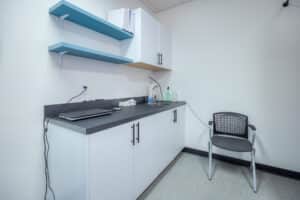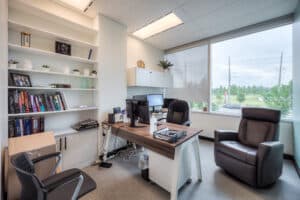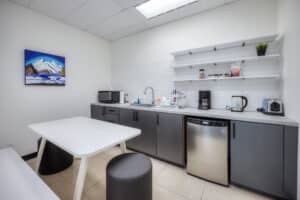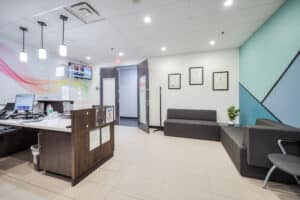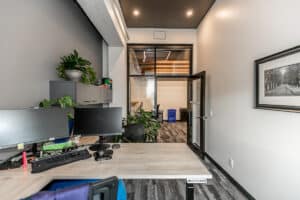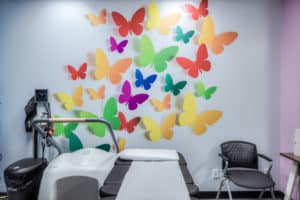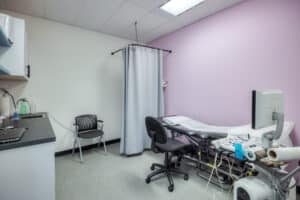How can clinics truly elevate the patient experience beyond just providing excellent medical care? It starts with creating an environment that feels safe, welcoming, and supportive from the moment a patient walks through the door. The power of healthcare interior design lies in its ability to transform clinical spaces into places of comfort and healing. When clinics invest in thoughtful commercial interior design and prioritize the use of ergonomic furniture, they not only improve patient satisfaction but also boost staff morale and operational efficiency. The right office interior design can make all the difference in how patients perceive their care and how smoothly a clinic runs.
First Impressions: The Waiting Area
The journey begins in the waiting area, where first impressions are formed. A well-designed waiting room, crafted with the principles of healthcare interior design, can immediately put patients at ease. Soft, calming colours, natural light, and comfortable, supportive seating are essential. Ergonomic furniture in the waiting area isn’t just about aesthetics—it’s about reducing anxiety and physical discomfort for patients who may already be feeling vulnerable. When commercial interior design is applied thoughtfully, the waiting area becomes a tranquil space that signals professionalism and care.
Navigation and Accessibility
Navigation and accessibility are also crucial in office interior design for clinics. Clear wayfinding, wide corridors, and accessible restrooms ensure that every patient, regardless of ability, can move through the space with confidence. Healthcare interior design must consider the needs of all users, from children to seniors, and create an environment that feels inclusive and easy to navigate. This attention to detail in commercial interior design not only enhances the patient experience but also streamlines the flow of staff and visitors, reducing stress and confusion.
Privacy and Comfort
Privacy is another cornerstone of a positive patient experience. In a clinic setting, healthcare interior design should include private consultation rooms, sound-absorbing materials, and thoughtful layouts that protect patient confidentiality. Office interior design can use partitions, acoustic panels, and strategic room placement to ensure that sensitive conversations remain private. This level of care in commercial interior design builds trust and reassures patients that their dignity and information are respected.
Material Choices and Ergonomics
The choice of materials and finishes in healthcare interior design also plays a significant role in patient comfort and safety. Non-slip flooring, rounded furniture edges, and easy-to-clean surfaces are all essential for reducing the risk of accidents and maintaining a hygienic environment. Ergonomic furniture is especially important in exam rooms and treatment areas, where patients may spend extended periods. Adjustable chairs, supportive beds, and height-adjustable workstations ensure that both patients and staff are comfortable and safe. This focus on ergonomic furniture in office interior design not only improves the patient experience but also helps prevent injuries and fatigue among healthcare professionals.
Biophilic Elements and Colour Psychology
Biophilic elements—such as indoor plants, nature-inspired artwork, and access to natural light—are increasingly recognized as vital components of healthcare interior design. These features have been shown to reduce stress, promote healing, and create a more positive atmosphere. When commercial interior design incorporates biophilic principles, clinics become spaces that nurture both body and mind. The integration of these elements into office interior design can be as simple as adding greenery to waiting areas or as comprehensive as designing entire rooms around views of nature.
Colour psychology is a subtle but powerful tool in healthcare interior design. Soft blues and greens can create a calming effect, while warmer tones can add energy to specific areas. The strategic use of colour in office interior design can influence mood, reduce anxiety, and make clinics feel less clinical and more welcoming. Commercial interior design experts understand how to balance colour, light, and texture to create spaces that feel both professional and comforting.
Technology Integration
Technology integration is another area where healthcare interior design can elevate the patient experience. Digital check-in kiosks, smart lighting, and integrated charging stations make visits more convenient and efficient. Commercial interior design professionals know how to seamlessly incorporate technology into the clinic environment without sacrificing comfort or aesthetics. In exam rooms, ergonomic furniture with built-in tech features allows for smoother consultations and better patient-provider communication, further enhancing the overall experience.
Staff Well-Being and Efficiency
Staff well-being is just as important as patient comfort in healthcare interior design. Clinics that invest in ergonomic furniture and efficient office interior design layouts help reduce staff fatigue, prevent injuries, and improve focus. When healthcare professionals feel supported by their environment, they can provide better care and interact with patients more compassionately. Commercial interior design that prioritizes staff needs ultimately leads to higher patient satisfaction and better clinical outcomes.
Attention to Detail
Every detail in healthcare interior design matters, from the placement of artwork to the selection of window treatments. The goal is to create a cohesive environment where every element works together to support patient wellness. Commercial interior design is about more than just looks—it’s about function, flow, and feeling. When clinics embrace the principles of office interior design and invest in high-quality ergonomic furniture, they send a clear message: patients and staff are valued, and their comfort and safety are top priorities.
Key Takeaways
- Thoughtful healthcare interior design directly impacts patient comfort, safety, and satisfaction.
- Commercial interior design blends aesthetics with functionality to create efficient, welcoming clinics.
- Office interior design should prioritize accessibility, privacy, and intuitive navigation for all users.
- Ergonomic furniture is essential for both patient comfort and staff well-being, reducing fatigue and injury.
- Biophilic elements and colour psychology in healthcare interior design promote healing and reduce stress.
- Technology integration in commercial interior design streamlines patient visits and enhances communication.
- Investing in professional office interior design and ergonomic furniture builds trust and boosts clinic reputation.
Final Thoughts
Elevating the patient experience in clinics starts with a commitment to exceptional healthcare interior design. By focusing on commercial interior design principles, investing in ergonomic furniture, and creating intuitive, welcoming office interior design, clinics can transform into spaces that heal, comfort, and inspire. Every design choice, from the waiting room to the exam table, shapes how patients feel and how staff perform. For clinics ready to step up their patient experience, partnering with a professional interior designer is the key to creating an environment where everyone thrives. If you want your clinic to stand out for its care, comfort, and efficiency, make healthcare interior design, commercial interior design, office interior design, and ergonomic furniture your top priorities.
Frequently Asked Questions (FAQ):
How does healthcare interior design improve the patient experience in clinics?
Healthcare interior design creates calming, accessible, and private environments that reduce anxiety, promote healing, and make patients feel cared for from the moment they arrive.
Why is ergonomic furniture important in office interior design for clinics?
Ergonomic furniture supports patient comfort during long waits or treatments and helps staff avoid fatigue and injury, leading to better care and a more positive clinic atmosphere.
What role does commercial interior design play in clinic efficiency?
Commercial interior design optimizes layouts, integrates technology, and ensures every square foot is used effectively, making clinics more efficient and pleasant for both patients and staff.
